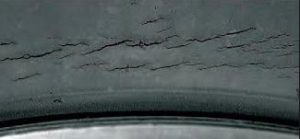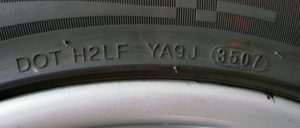Last Updated on February 24, 2024
How Old Are My Tires? DOT Date Code Tells You
Are you concerned about the age of your tires?
Ready to Decipher the DOT Date Code for Safer and Smarter Tire Choices?
Tires are essential to our vehicles, keeping us safely connected to the road. Like all products, tires have a life cycle, and knowing the age of your tires can be crucial for safety reasons. Enter the DOT Date Code. This seemingly cryptic set of characters holds valuable information about when your tire was manufactured.
This quick guide will help you find the manufacture date of your tire and understand how Tires Easy handles tire age based on the DOT Code. Keeping a record of your tires and understanding their age will help you save money on repairs and take proper care of your vehicle.
What Is Tire DOT Date Code?
To find your tire’s age, you must locate the DOT Date Code on the tire. This symbol indicates the tire manufacturer’s compliance with the U.S.
“Every tire sold in the United States carries a DOT code, a testament to meeting the U.S. Department of Transportation’s standards. The last four characters of this code represent the DOT Date Code, revealing the week and year the tire was produced.”
Department of Transportation (DOT) National Highway Traffic Safety Administration (NHTSA) safety standards. It tells you who manufactured the tire, where it was made, and other tracking information. Plus, it indicates that the tire has passed the Department of Transportation’s testing and NHTSA manufacturer requirements.
The raised numbers of the DOT Code are placed together and often enclosed in a raised oval. The first two numbers are the week the tire was manufactured. In the example below, 35 stands for “week 35.” The second two numbers are the year the tire was manufactured. The image below shows the 07, indicating the tire was built in 2007. This particular tire was made in the 35th week of 2007.
On tires manufactured in 2000 and after, the last four digits indicate the week and year the tire was produced. The first two digits identify the week, and the second two identify the year.
Decoding the Numbers
Imagine a DOT Date Code reading ‘2321’. The first two numbers, ’23’, indicate the week of manufacture, while the last two numbers, ’21’, represent the year. Thus, this tire was made in the 23rd week of 2021.
Where to Find the DOT Code on the Tire
It’s not always easy to find the tire DOT code. There aren’t regulations on where the manufacturer has to place the information, so you may need to look at multiple sides of your tires before finding the numbers. However, the identification information is usually on the inner sidewall of tires.
Tires-Easy Tire Age Warranty
At Tires Easy, we believe the tire warranty should begin from the date of purchase, not the DOT Code. If you purchase new tires today, and the DOT Code was a year ago, your warranty will still begin on the purchase date, not the tire’s manufacture date.
If, for any reason, you are uncomfortable with the age of your tires after looking at the DOT Date code, please call us, and we can quickly provide you with a return under our 45-day return policy.
Why Should I Be Concerned About the DOT Date Code?
Just because you buy “new” tires doesn’t mean they were made recently. Tires can take a while to reach tire retailers after being shipped from the manufacturer. Checking your tires’ DOT Date Code will tell you when they were made and how long they may have been stored. It is essential to know that tires are often for months or years at a time, so your tire’s DOT code might not be in the same year you bought the tires, and that’s not a concern.
At Tires Easy, we take tire protection VERY seriously. Once the tires reach us, they are moved into Tires Easy’s industrial tire warehouses to ensure proper storage and prevent exposure to seasonal weather conditions. Our storage locations are fantastic, climate-controlled, and dry, preventing premature aging or damage.
Poor storage conditions can rapidly accelerate tire aging, so you should be sure the tires you purchase have been properly stored.
Why is the DOT Date Code Important?
- Safety First: Tires degrade over time. Even if they look in good condition, the rubber can weaken, making them more susceptible to failure. Knowing the age helps in assessing their reliability.
- Maximizing Value: The DOT Date Code ensures you’re not getting old stock when purchasing new tires. Tires sitting on shelves for extended periods may not offer the best performance.
- Warranty Claims: Some tire warranties are based on the purchase date, while others consider the manufacture date. The DOT Date Code can aid in any potential warranty claims.
How Old is Too Old?
Various industry associations worldwide agree that tires have a helpful service life of six to ten years. As technology changes, there are more materials and combinations of compounds to extend tire life and wear. At Tires Easy, we like to err on caution and only sell seven-year-old and under tires.
Considering the average driver travels 15,000 miles yearly, most tires must be replaced in 4 years. If your tires were a few years old when purchasing, you would still be well within the accepted tire age range. This is especially true if the tires receive the proper care and maintenance throughout their lifetime.
You must replace your tires when the tread depth falls below 1.6 mm. Additionally, changing summer tires’ tread depth to 3 mm and winter tires’ tread depth to 4 mm is recommended. This keeps your tires at optimal levels of safety.
When your tires reach seven years of age, we recommend that you consider replacing them. Even if the tires look new, it is best to have them inspected by a professional tire installer so they can adequately advise on the safety of the tires moving forward. Spare tires should be checked and replaced as well.
No matter how old the tires are when you buy them, the most important aspect of tire safety is regular maintenance and inspection, according to the Rubber Manufacturer’s Association of America and the Tire & Rubber Association of Canada.
“Since service and storage conditions vary widely, accurately predicting the service life of any specific tire based on calendar age is impossible.”
For this reason, there is no specific limitation on the tire’s age when it is sold based on its DOT Code.
How Often Should I Check the DOT Date Code?
It’s wise to inspect the DOT Date Code:
- When purchasing new tires.
- During routine vehicle maintenance or tire rotation.
- If you suspect your tires are aging and might need replacement.
Common Misconceptions About DOT Code Tire Age
1. Regarding the DOT Date Code, some might assume that the number stated when the tire was approved. On the contrary, the DOT symbol indicates that the Department of Transportation supports the tire to be legally used on the road. The Date Code is when the tire was manufactured (not when it was approved).
2. You might also have heard that you should only buy tires with a DOT code within the current year. As we mentioned earlier, this is often not the case with many tires simply because it takes time for the tire to reach the United States from the manufacturer.
As long as the tires have been stored properly, they will be in excellent condition, even if the DOT Date code is a few years old.
Proper Storage Increases the Life of the Tire
When stored properly and protected from the elements, tires age quite slowly. The Rubber Manufacturers Association has said there’s no way to put a date on when tires actually “expire.” There are too many factors that impact the actual age of a tire.
To help prolong the life of a tire, tire retailers will:
- Protect the tires from UV rays or excessively high temperatures.
- Keep the tires cool and dry to prevent deterioration.
- Eradicate moisture or humidity that could compromise the tires.
- Prevent tires from freezing when temperatures drop.
While these are the main contributors to excessive tire aging, it would still take years of exposure in the hottest, wettest, and driest climates for the first signs of tire aging to appear. Tires are durable, and if they show signs of damage within the first few years, it’s a sign of poor quality.
Whitening of the rubber and shallow hairline cracks in the upper or lower sidewall may indicate UV and heat damage, but these symptoms aren’t common issues in new tires.

Tips for Prolonging Tire Life
Navigating the world of tires can seem tricky, but it becomes a smooth ride when you’re armed with the proper knowledge. The DOT Date Code is crucial information stamped on every tire. Understanding this code and how to care for your tires can be a game-changer. Let’s break it down.
1. What’s the DOT Date Code Anyway?
The DOT Date Code is a small set of numbers at the end of your tire’s more extended DOT code. This code is about dates – it tells you when your tire was made. For example, if you see ‘2321’, the tire was manufactured in the 23rd week of 2021. Why’s that important? Like all things, tires age, and knowing their “birthday” helps you understand if they’re fresh or nearing the end of their best performance.
2. The Importance of Fresh Tires
While tires might look sturdy, they can age and weaken over time. A tire sitting on a shelf for years might not be as safe or perform as well as a newer one. So, when shopping for tires, a recent DOT Date Code ensures you’re truly getting the best for your vehicle.
3. Safety Checks with the DOT Date Code
Have you ever heard of recalls? Sometimes, specific batches of products, including tires, might have issues. If there’s ever a recall on your tire, the DOT Date Code helps identify if your tire belongs to that problematic batch.
4. Boosting Your Tire’s Life: Tire Care Tips
Apart from the DOT Date Code, there are simple ways to ensure your tires last longer:
- Regular Checks: Make it a habit to inspect your tires visually. Look out for any cuts, bulges, or anything that seems off.
- Pressure Matters: Ensure your tires are always inflated to the recommended pressure. This avoids unnecessary wear and can even save on fuel.
- Rotate Regularly: This means changing the position of your tires. For example, moving the front ones to the back and vice versa. It helps in even wear, ensuring they all last longer together.
5. Using the DOT Date Code for Warranties
Regarding warranties, some brands base their timeframes on purchase dates, while others might look at the manufacture date. Knowing how to read the DOT Date Code ensures you have the necessary information if a warranty situation arises.
The DOT Date Code is more than just numbers on your tire – it’s a gateway to understanding its age, ensuring safety, and making informed choices. Pair this knowledge with regular tire care, and you’re on your way to safer, longer-lasting drives. Safe travels!
Conclusion
The DOT Date Code, imprinted on every tire’s sidewall, serves as a clear testament to transparency and safety standards in the tire industry. Acting as a tire’s “birth certificate,” it offers consumers invaluable information about a tire’s age, ensuring they can make informed decisions regarding tire purchases, maintenance, and replacements. This small yet crucial set of numbers ensures that the tire industry remains accountable and consumers remain informed, fostering trust and ensuring road safety for everyone.
The DOT Date Code is a small but mighty tool in your tire knowledge arsenal. By understanding and regularly checking this code, you’re ensuring a smoother ride and prioritizing the safety of you and your loved ones.
Ready to make a wise and informed tire choice?
Find the perfect, age-appropriate tires for your vehicle at Tire Easy. Ensure your journey’s safety and efficiency – Buy Now.
If you have any questions about your tire’s DOT Code or age, contact us and let us assist you!
FAQs
Do tires get stiff with age?
The rubber gets hard over time as the tire loses its elasticity. This happens regardless of how much you use your tires over the years.
Is there a firm date to replace my tires?
Every tire has a birthday; many will not be sold seven years later. However, since some tires don’t technically become unsafe until a decade after they’re produced, the best advice is to have your tires checked by a professional to ensure they are safe for continued driving.
How do you read a DOT Date Code?
The DOT Date Code is typically a three or 4-digit number found at the end of the DOT code on a tire. This code reveals the week and year the tire was manufactured. For a 4-digit code, the first two numbers represent the week, while the last two represent the year. For instance, ‘2321’ indicates the tire was made in the 23rd week of 2021.
What is a 3-digit DOT Date Code?
A 3-digit DOT Date Code was used on tires manufactured before the year 2000. The first two digits still represent the week of manufacture, but the last digit refers to the previous year of the decade. For instance, ‘238’ would mean the tire was made in the 23rd week of the 8th year of a decade (likely 1998). However, this method could be ambiguous, so from 2000 onward, a 4-digit code has been used to eliminate confusion.
How do I find my DOT Code?
The DOT code can be found on the sidewall of every tire. It usually starts with the letter “DOT,” followed by characters representing details about the tire and its manufacturing. The code’s last 3 or 4 digits (depending on the tire’s age) represent the DOT Date Code, indicating the tire’s manufacturing date.
What does the DOT code stand for?
“DOT” stands for the Department of Transportation. The DOT code on tires signifies that they meet all federal standards set by the U.S. Department of Transportation and provides information about the manufacturer, brand, and the date it was made, among other things.











